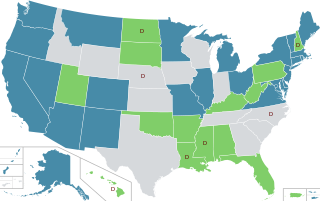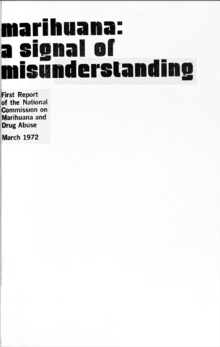The National Organization for the Reform of Marijuana Laws is a social welfare organization based in Washington, D.C., that advocates for the reform of marijuana laws in the United States regarding both medical and non-medical use.

The war on drugs is the policy of a global campaign, led by the United States federal government, of drug prohibition, foreign assistance, and military intervention, with the aim of reducing the illegal drug trade in the US. The initiative includes a set of drug policies that are intended to discourage the production, distribution, and consumption of psychoactive drugs that the participating governments, through United Nations treaties, have made illegal.

The LaGuardia Committee report was an official scientific report published in 1944 that questioned the prohibition of cannabis in the United States. The report contradicted claims by the U.S. Treasury Department that smoking marijuana deteriorates physical and mental health, assists in criminal behavior and juvenile delinquency, is physically addictive, and is a "gateway" drug to more dangerous drugs.

In the United States, the non-medical use of cannabis is legalized in 24 states and decriminalized in 7 states, as of November 2023. Decriminalization refers to a policy of reduced penalties for cannabis offenses, typically involving a civil penalty for possessing small amounts, instead of criminal prosecution or the threat of arrest. In jurisdictions without penalty the policy is referred to as legalization, although the term decriminalization is sometimes used for this purpose as well.

In the United States, increased restrictions and labeling of cannabis as a poison began in many states from 1906 onward, and outright prohibitions began in the 1920s. By the mid-1930s cannabis was regulated as a drug in every state, including 35 states that adopted the Uniform State Narcotic Drug Act. The first national regulation was the Marihuana Tax Act of 1937.

Drug liberalization is a drug policy process of decriminalizing, legalizing, or repealing laws that prohibit the production, possession, sale, or use of prohibited drugs. Variations of drug liberalization include drug legalization, drug relegalization, and drug decriminalization. Proponents of drug liberalization may favor a regulatory regime for the production, marketing, and distribution of some or all currently illegal drugs in a manner analogous to that for alcohol, caffeine and tobacco.
The Personal Use of Marijuana by Responsible Adults Act of 2008 was a bill in the United States House of Representatives introduced by Barney Frank (D-MA) in the 110th congress on April 17, 2008 as H.R. 5843. The bill had a total of 8 cosponsors. Its passage would have eliminated federal criminal penalties for possession of up to 100 grams (3.5 oz) and nonprofit transfer of up to an ounce of cannabis under the Controlled Substances Act. It does not change the regulation on the manufacturing or the sale of cannabis. It is the first bill of its kind to be introduced at the federal level in the U.S. since 1984.

The Sensible Marijuana Policy Initiative, also known as Massachusetts Ballot Question 2, was an initiated state statute that replaced prior criminal penalties with new civil penalties on adults possessing an ounce or less of marijuana. The initiative appeared on the November 4, 2008, ballot in Massachusetts.

In the United States, the use of cannabis for medical purposes is legal in 38 states, four out of five permanently inhabited U.S. territories, and the District of Columbia, as of March 2023. Ten other states have more restrictive laws limiting THC content, for the purpose of allowing access to products that are rich in cannabidiol (CBD), a non-psychoactive component of cannabis. There is significant variation in medical cannabis laws from state to state, including how it is produced and distributed, how it can be consumed, and what medical conditions it can be used for.
This is a history of drug prohibition in the United States.
Proposition 19, also known as the California Marijuana Initiative (CMI), was a ballot initiative on the November 7, 1972 California statewide ballot. This was the first attempt to legalize marijuana by ballot measure in the history of the United States. If it had passed, the measure would have removed penalties in the State of California for persons 18 years of age or older for using, possessing, growing, processing, or transporting marijuana for personal use. The California Marijuana Initiative's organizers coordinated a huge grassroots organizing drive to place the measure on the ballot. The initiative qualified for the November statewide ballot in June 1972. The initiative was defeated by the voters with 66.5% No votes to 33.5% Yes votes.
Henry Brill was an American psychiatrist and educator. A native of Bridgeport, Connecticut, he earned both his undergraduate and medical degrees from Yale University. After receiving his M.D. in 1932, he began a career in the New York state psychiatric system, culminating in the directorship of Pilgrim Psychiatric Center in Brentwood, NY from 1958 to 1976. At its height in the mid-1950s, Pilgrim was the largest mental institution in the world, with a census of 13,875 patients. Brill also served as Deputy Commissioner of the New York State Department of Mental Hygiene from 1959 to 1964.

The legal history of cannabis in the United States began with state-level prohibition in the early 20th century, with the first major federal limitations occurring in 1937. Starting with Oregon in 1973, individual states began to liberalize cannabis laws through decriminalization. In 1996, California became the first state to legalize medical cannabis, sparking a trend that spread to a majority of states by 2016. In 2012, Washington and Colorado became the first states to legalize cannabis for recreational use.

Cannabis in New Mexico is legal for recreational use as of June 29, 2021. A bill to legalize recreational use – House Bill 2, the Cannabis Regulation Act – was signed by Governor Michelle Lujan Grisham on April 12, 2021. The first licensed sales of recreational cannabis began on April 1, 2022.

Terms related to cannabis include:
Cannabis in Mali is illegal.
Mariajuana Smoking in Panama is the title of a 1933 report created by United States Army Medical Corps Colonel Joseph Franklin Siler for the Commanding General of the Army's Panama Canal Department concerning cannabis (marijuana) use by U.S. military members. Use at that time in the Panama Canal Zone, then a U.S. territory, was a concern for military discipline and health.
During the administration of American President Jimmy Carter (1977–1981), the United States gave further consideration to the decriminalization of cannabis (marijuana), with the support of the president. However, law enforcement, conservative politicians, and grassroots parents' groups opposed this measure. The net result of the Carter administration was the continuation of the War on Drugs and restrictions on cannabis, while at the same time cannabis consumption in the United States reached historically high levels.
During the administration of American President Richard Nixon (1969–1974), the United States turned to increasingly harsh measures against cannabis use, and a step away from proposals to decriminalize or legalize the drug. The administration began the War on Drugs, with Nixon in 1971 naming drug abuse as "public enemy number one in the United States."








